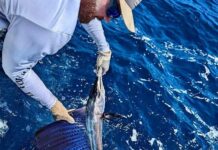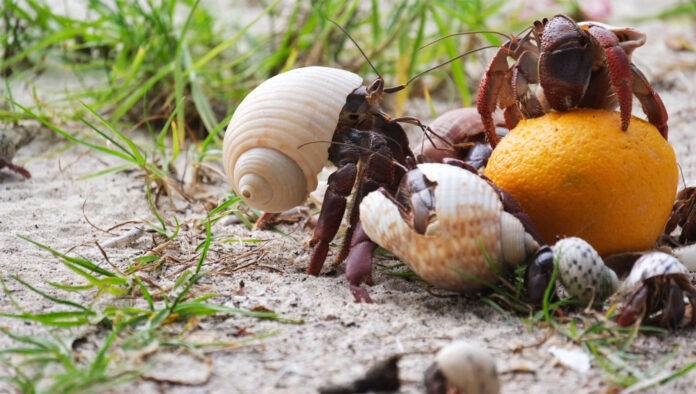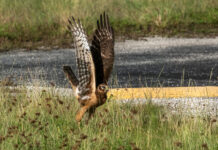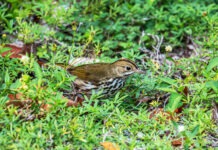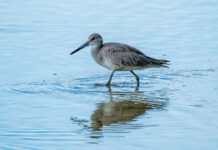I was lucky enough to spend some time on a backcountry island a few years ago. There was a house, but it was pretty much off the grid, miles from the pipes and wires that connect the rest of the world, though you could send or get the occasional text, especially if you went up onto the roof.
One of my favorite things to do out there, besides bask in the raw natural beauty of it all, was to scrape the remnants from my dinner plate over the side of the porch railing and then wait for things to happen. There was an empty sandy patch below, covered in tracks that looked like the script of a lost language written by tiny, asymmetrical sets of feet.
The hermit crabs were reliable, though not exactly swift. They tended to hide in the shadows until they had a reason not to.
I’m not sure if they were attracted by the smell or the sound or the vibrations of food hitting sand. Usually one of the smaller ones would notice it first and make a shambling beeline for the closest pork chop bone, half tater tot, bread crust, bit of fish, pepper slice or Rorschach splat of rice.
It is tempting to get judgmental about the hermit crabs’ pokiness. In their defense, if you looked at the scale, the 6 feet of sand they needed to cross looked to be the equivalent of 200 yards for a human. Also, they always have to carry their house with them, a house that wasn’t exactly purpose-built for them in the first place.
So it would start with one crab. But when a hermit crab gets specific about their routes, the other crabs notice. The first one there would have a minute or two to get started, shoving bits of food into its mouth with the smaller of its two pincers. Other, similar hermits would show up, then slightly larger ones, and then ones even larger, as if the crabs only got interested when the members of the size class just below them started to move.
Eventually there would be a swarm, a dogpile of hermit crabs over every bit of dropped food. Sometimes it would be peaceable. Sometimes there would be battles. Their battles always reminded me of cheap claymation.
I dropped a navel orange down into the sand once and filmed the commotion. After a short while one of the larger hermits – the Jack Reacher of hermit crabs – had crawled on top and looked not unlike the cover illustration for “The Little Prince,” if the little prince was a large hermit crab who made you think of Jack Reacher. Soon it had a hole through the rind, and was dropping its smaller claw down into it, excavating pincers-full of pulp. Occasional a smaller pretender to the throne would come along and try to throw down on him, and it would fling them off.
Eventually a hermit crab slightly larger than he approached – an even more Jack Reacher-y hermit crab – and the two had a sort of wet noodle slap fight with their antennae. Finally the bigger one gained some purchase on the rind, climbed up, and flung the slightly smaller one off like a piece of old luggage.
In every hermit crab battle I ever saw, the larger hermit always won, though the smaller hermits never left without a fight. The losers were never visibly injured or anything. The battles just looked to be their way of sorting out the order of things.
At some point I realized I needed to get past the UFC aspects of their behavior and read up on them.
Turns out there are about 600 species of hermit crabs in the world, but there are only a couple dozen species of land hermit crabs. In the Keys, as well as the rest of the Caribbean, we have the Caribbean Hermit Crab, sometimes called the Purple Pincher, the Tree Crab, the Soldier Crab or Coenobita clypeatus if you want to get all Latin about it.
Caribbean Hermit Crabs are one of the two species generally sold in pet stores in the U.S. (The other is the Ecuadorian Hermit Crab.) Neither can be bred in captivity, so the ones sold as pets are harvested in the wild.
A hermit crab in the wild can live up to about 12 years. The ones kept as pets tend to die in a few months. Except for one named Johnathon Livingston Crab, whose owner bought her (turns out Johnathon was female) at the Maryland shore in 1976, and kept her alive for more than 45 years.
Hermit crabs are not true crabs – they are more closely related to lobsters. As their name suggests, unlike, say, snails, they do not create their own shells, but instead evolved about 150 million years ago to live in shells abandoned by other creatures, usually gastropods such as marine snails. They can be pretty adaptable, though. The first time I remember seeing a hermit crab in the Keys, it was living in a plastic shampoo bottle cap on Boca Chica Beach.
The front half of their body has a hard exoskeleton. The back half does not, and is built to curve into the spirals of the shells they select. Of their ten legs, the first two function as claws, the next four are used to walk, and the other four are much smaller in size and are used to essentially stay gripped into the shell.
I’ve seen hermit crabs in shells not much bigger than a pencil point, and in shells not much smaller than a lemon. They need to move into a larger shell every year to year-and-a-half. Apparently there are two ways of doing that. In one, a hermit crab comes across an appropriately large shell and simply abandons its old shell and moves into the new one. (Apparently, given the choice to move into a shell that has been lived in by another hermit crab, or a shell that has not been lived in by another hermit crab, they will choose the used shell almost every time.)
The other way is a little more communal. Essentially, if a large hermit crabs finds an abandoned larger shell, and there are other hermits around, it will move into the new shell, then the next smaller hermit will move into its old shell, and the next smaller one will move into that abandoned shell, etc., etc., until everyone has upgraded.
I never had the chance to see that on that backcountry island, or anywhere I’ve wandered around the Keys since. But I’m still hoping.












